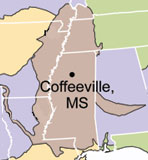|
| |
About the Jamie L. Whitten Plant Materials Center
Updated
08/25/2008
| Established |
1960 |
| Size |
360 Acres |
| Land Ownership |
US Forest
Service |
| Operation |
NRCS |
Description of the PMC Service
Area
 The areas served by the Jamie L.
Whitten Plant Materials Center are usually rolling except for nearly level floodplains and narrow
cliffs along streams and rivers. The areas served by the Jamie L.
Whitten Plant Materials Center are usually rolling except for nearly level floodplains and narrow
cliffs along streams and rivers.
The climate is temperate and humid. Average rainfall is about 50 inches, and the
temperature increases greatly from north to south. Frost-free days range from
about 200 in the north to 340 in the extreme south.
Although rice, sugarcane and catfish farming are important in some locations,
cotton and soybeans dominate the service area. Continuous cropping of cotton and
soybeans using conventional methods are a major cause of soil erosion in the
service area. Other causes of erosion needing attention are clear cutting,
construction, and mining. Facilities at the PMC consist of an office
and laboratory complex, a greenhouse complex, seed cleaning and warehouse
buildings, shop and equipment storage areas, and fuel, fertilizer, and
herbicide storage buildings. A constructed wetland provides waste and storm
water treatment for the greenhouse complex.
Many of the facilities listed above resulted
from an expansion program begun in 1990 to upgrade this center. The service
area includes portions of seven states, with the laboratory facility
designed to meet the water quality and forage testing needs of this and
other PMCs. Space is available in the greenhouse complex for expansion of
laboratory capacity as future objectives and funding permit.
The PMC occupies approximately 200 acres of
open fields. The growing areas consist of both bottomland and upland fields,
with most being of irregular size and shape, defined by streams, drainages,
roads, and other topographic features. Bottomland fields primarily have
Oaklimeter silt loam soils, which are acid and often wet. With proper
drainage and management these soils can become very productive. The upland
soils are predominantly Loring and Grenada silt loams with fragipans. These
soils are also acid and moderately to highly productive. This variety of
available growing sites permits plant evaluation under conditions
representative of much of the service area. Tests may also be located at
sites off the center, which further broadens the available range of testing
situations. Specialized aquatic cells are located at the PMC for use in
production and evaluation of aquatic plants.
Getting to the Jamie L.
Whitten
PMC
The Jamie L. Whitten Plant
Materials Center is located in northwest Mississippi approximately 112 miles
North of Jackson, Mississippi and 85 miles South of Memphis, Tennessee off
I-55. From Jackson or Memphis take exit 220 (Tillatoba Road) and travel
approximately five miles east on highway 330.

History of the PMC
The Coffeeville PMC began
operations on August 8, 1960 functioning both as a PMC and a seed production
unit for the Yazoo-Little Tallahatchie Flood Prevention Project. The seed
production unit was discontinued in 1982, and the plant materials function
was reorganized and expanded. During its tenure, the PMC has evaluated over
6,800 plant accessions for erosion control on cropland, stream channels and
critical areas, as well as for forage production, wildlife food and cover,
and wetland mitigation and restoration.
Cooperative Work at the PMC
The PMC works cooperatively
with other agencies and organizations in carrying out its functions.
Cooperators include the Mississippi Agricultural and Forestry Experiment
Station (MAFES), Mississippi Association of Conservation Districts, USDA
Forest Service, USDA Agricultural Research Service, and various colleges and
universities. The PMC also has cooperative agreements with the National Park
Service (NPS) and the Mississippi Military Department.
< Back to Jamie L. Whitten Plant Materials Center
| |
|

